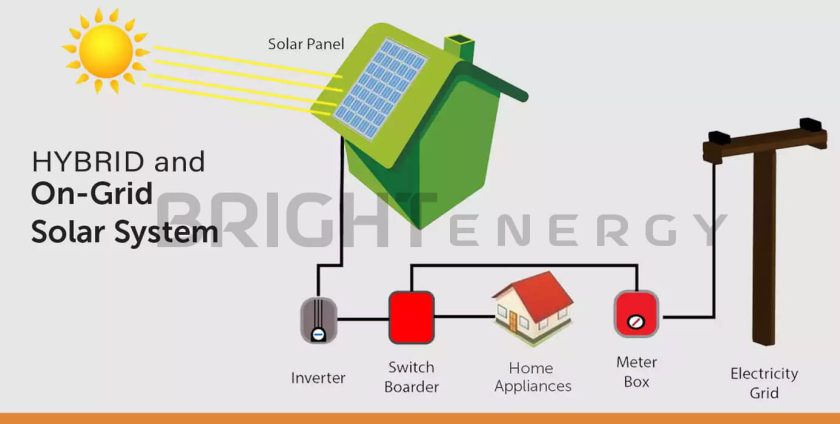
People are rapidly shifting to solar power systems for energy uses as it is cost-effective and provide sustainable and long-term usage. The decision to invest in a solar energy system is a significant step toward a more sustainable and cost-effective energy future. The solar panels and systems work on the same principle of using sunlight to convert the sunlight into DC energy using Photovoltaic PV panels.
Types of Solar System in Pakistan
However, when it comes to solar systems, not all are created equally. Two primary types of solar setups often come into consideration: On-Grid Solar Systems and Hybrid Solar Systems. Each has its benefits and limitations, making it crucial to understand the differences to determine which one best suits your specific energy needs.
On-Grid Solar vs. Hybrid Solar Systems: Making the Right
Choice for Your Energy Needs
As there are different types of Solar energy systems, users and potential users should know th e difference between them. In this blog, we will discuss the difference between on-grid and hybrid solar system so that the users can easily pick their choice.
On-Grid Solar Systems: Tied to the Grid
On-grid solar Systems, also known as grid-tied or grid-connected systems, are the more traditional approach to harnessing solar power. These systems are directly connected to the electrical grid, and their operation relies on this connection.
On-grid systems generate the DC power using Photovoltaic PV panels. On-Grid systems feed excess electricity generated by solar panels back into the grid. It means that when your solar panels produce more electricity than you need, it’s sent to the grid, and you receive credits for this surplus energy. This system is also known as Net Metering.
By generating your electricity and utilizing net metering, electricity bills are significantly reduced. Depending on sunlight availability and system size, even a net-zero electricity bill can be achieved.
On-Grid systems are relatively straightforward to install and maintain because they do not require energy storage solutions like batteries. They are often a more cost-effective initial investment compared to Hybrid systems.
On-Grid systems are reliable as you have a continuous and reliable source of electricity from the grid, ensuring power availability even when your solar panels are not producing energy (e.g., at night or during cloudy days).
Limitations:
However, On-Grid Solar Systems have limitations too, including their dependency on the grid. Net Metering does not work in the time of load-shedding, grid outages, and blackouts. The grid is not working and is closed for the time being. If the solar power system keeps on producing the current and sends extra current to the grid, it can be very dangerous and can result in electrical damage. It can also pose safety risks to utility workers.
Hybrid Solar Systems: Combining Solar and Energy Storage
Hybrid Solar Systems offer a more versatile and self-sufficient energy solution. These systems integrate solar panels with energy storage, usually batteries, and can operate both connected to the grid and independently. Hybrid systems store excess solar energy in batteries for later use. It means you can power your home or business with solar energy even when the sun is not shining or during grid outages.
With a Hybrid Solar system, you reduce your reliance on the grid and have a reliable backup power source, making it an ideal choice for areas with unstable grid infrastructure or frequent power outages. In the daytime, the solar panel’s energy can be used. But as the sunlight dims in the evening or on a cloudy day, the grid electricity can be easily used as a backup if battery charging is over. In case of power shortage at night, users can opt for battery charging just like they use UPS power. In this way, Hybrid systems allow users to maximize their self-consumption of solar energy.
As the name hybrid suggests, Hybrid systems can operate as On-Grid systems or Net Metering, and sell excess energy back to WAPDA when it’s beneficial.
As the system is hybrid, two or more energy sources are being used to maintain a stable and interruption-free energy flow. By reducing your reliance on the grid and using stored solar energy, Hybrid systems can further reduce your carbon footprint and environmental impact.
Limitations:
While Hybrid Solar Systems offer increased energy independence and versatility, they do come with a higher initial investment cost due to the addition of energy storage components like batteries. Additionally, they require more installation and maintenance for long-lasting results.
Choosing the Right System for You
The choice between On-Grid and Hybrid Solar Systems depends on your specific needs, location, and priorities.
On-Grid systems are often a cost-effective choice for reducing electricity bills and contributing to sustainability, especially in areas with a reliable grid. It is a good option for urban settings.
Hybrid systems, on the other hand, offer energy independence and reliability, making them suitable for areas with unstable grids or frequent power outages. It is a good option for rural settings.
Ultimately, your decision should align with your energy goals and budget. Consulting with Bright Energy can help you evaluate your options and design a system tailored to your unique requirements, ensuring you make the right choice for your energy needs and future sustainability goals.

Leave a Reply